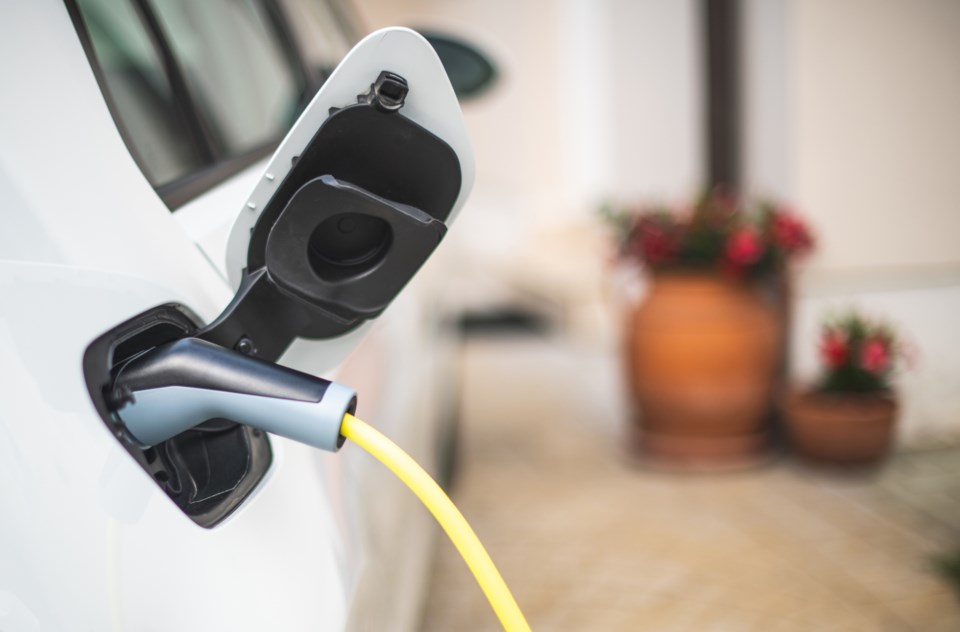The provincial government “missed the point” about a request to allow anyone to plug in their electrical vehicles, according to Richmond's mayor.
The Union of BC Municipalities (UBCM) asked the province to enact a “right to charge” law that would stop stratas from prohibiting residents from plugging in their EVs.
However, the province’s response focused on the fact that, since 2018, they've allowed stratas to charge fees from residents who are charging up their EVs.
“I would suggest that the province missed the point (in its response to UBCM),” Mayor Malcolm Brodie said at Monday’s council meeting. “The point is you might have a user who wants to hook up their EV charger and the strata corporation is prohibiting that, so you want the right to charge, presumably at your own expense.”
Richmond city council voted unanimously on Monday to lobby the provincial government for “right to charge” legislation, something suggested by Steveston resident John Roston at a recent public works committee meeting.
This right would promote EV charging infrastructure installation in strata and apartment buildings.
In its request to the province, UBCM pointed out people living in multi-family buildings “do not have legal recourse if they are refused permission to install or use (EV) charging infrastructure in their own parking stall.”
“In a perfect world,” it would be great to install EV chargers in all strata parking stalls, but the capacity and affordability issues don’t currently allow it, said Tony Gioventu, CEO of the Condo Home Owners Association of B.C. (CHOA).
“I appreciate local governments doing this, but you have to step back and see what are the practicalities,” Gioventu said.
Multi-family buildings facing growing electrical demands.
In addition to the growth in EVs and, therefore, the need for more charging stations, these buildings are facing other growing electricity demands such as heat pumps and other cooling systems.
There’s a need for a “broader coordinated approach” to manage charging systems so that the overall system isn’t over-burdened, Gioventu said.
Even buildings built within the last 10 years can’t handle much more demand than they currently have, he added.
Gioventu said the first step, if a strata is interested in installing EV chargers, is to find an electrical consumption expert who can assess the building’s and the neighbourhood’s electrical capacity.
CHOA is working on a study with BC Housing, expected to be released in the fall, on the capacity of buildings to take on the growing electrical needs across the province.
“Right to charge” laws in California and Hawaii give residents in multi-family buildings the right to install a charging station for their own use, according to NESCAUM, an air-quality non-profit in the Northeast U.S.
But conditions apply, for example, the individual has to pay all costs, and this right doesn’t mean homeowner associations or rental property owners are required to pay the charging costs or installation of equipment, according the NESCAUM.
The province’s response to the UBCM request for “right to charge” legislation was to point out they allow stratas to now charge “consumption-based user fees” for EV chargers on common property.
“As a result, strata corporations now have the option to recover installation, operating and maintenance costs for the charging station via a user fee,” the province told UBCM.
Coun. Carol Day suggested the name “right to charge” be changed to “right to plug in” to clarify it’s not about charging fees, rather about allowing all residents to have charging stations.
Not all new buildings install EV chargers: McPhail
Since 2017, the City of Richmond has required all new residential parking spots to have electrical outlets that can support Level 2 EV charging.
However, the actual charging stations don’t necessarily get built, according to Coun. Linda McPhail.
“While we require all new multi-family complexes to rough in the electrical for EVs, it’s my understanding that often strata councils often put off the actual installation as it’s cost-prohibitive and perhaps there are only a few EV owners in the building,” McPhail said. “And we know older buildings are also lagging behind.”



